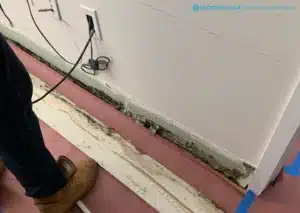One of the most common misconceptions about mold is that it only grows in warm weather. While mold growth may be a more common topic during the spring and summer, it’s a year-round problem that you should be aware of.
Below, we’ll discuss the reasons why mold can still grow in winter, ways you can help prevent mold growth in your property, and what you should do if you see mold in your home or business.
How Does Mold Grow In Winter?
While it’s more common to worry about mold growth during the warmer months, it should be a concern all of the time. Mold growth isn’t a seasonal problem. And it isn’t just confined to warmer environments.
Mold can affect your property at any time. It just needs four things to help it grow and thrive:
- Moisture
- Warm Temperatures (typically between 60°F and 80°F)
- Oxygen
- A Food Source (wood, carpet fibers, fabrics, plastic/metal/concrete covered in dirt)
Taking these factors into consideration, we’ll present a typical example of how mold growth can affect a property during winter: A finished basement in a residential property experiences a mild amount of water damage due to thawing snow leaking into a window. When that moisture mixes with oxygen, carpet fibers (food source) and the warmer household temperatures (caused by the heater running more frequently), then mold growth occurs.
The seeds of mold growth can also be planted during the winter only to affect the property during the warm weather months. That’s because cold and frigid temperatures do not kill mold spores – they just deactivate them. Mold spores lie dormant during frigid temperatures only to reactivate and grow as the seasons change and warmer temperatures become constant. An example of this instance would be if an unfinished basement experiences water or flood damage during the winter. While no mold grew due to freezing temperatures, the affected area begins to show signs of mold growth as the weather warms and the mold spores spring into action.
Tips To Prevent Mold Growth In Winter
If you’re wondering if there are any ways you help prevent mold growth from affecting your property during the winter months, you’ll be happy to hear that the answer is “Yes!”
By taking the following measures, you’ll be able to help stop or curb the growth of mold in your house during the winter:
- Maintain an interior humidity level of 50% throughout your property by using a dehumidifier
- Try to identify areas where water may be collecting or pooling
- Inspect pipes, water heaters, doors and windows for signs of leaking
- Insulate unheated interior areas of the home and exposed pipes to prevent freezing and bursting
- Remove carpeting or rugs from areas that are frequently exposed to water (kitchens, bathrooms)
- Clean gutters and drainage systems to prevent clogs and flooding
What To Do If Your Property Has Mold
If you suspect your property is experiencing mold growth, do not try to remove the spores with household cleaning products or bleach. This will just remove surface level mold and not the spores that are lingering beneath the surface. They will continue to grow and make matters worse.
Since mold is a very serious problem, it’s best to leave the removal process to the professionals.
If mold growth has affected your property, be sure to call FloodCo USA.
Using state-of-the-art equipment and techniques, our certified mold removal and remediation experts will:
- Locate and contain the mold-infected area or areas of your property
- Prevent airborne mold spores from leaving the containment area and contaminating other areas of the property
- Remove or treat the affected area based on the severity of mold infestation.
- Trap the mold and prevent it from releasing any more spores using specialized paint/sealant
- Paint and patch any surfaces (if necessary)
- Run tests to ensure that mold growth is no longer occurring
If your property has been affected by mold growth any time of the year, contact the mold removal and remediation experts at FloodCo USA!



